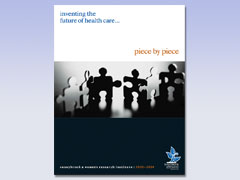A Labour of Love
Labour and delivery is hard work for mothers and doctors alike. But when Dr. Mary Hannah stepped out of the delivery room in 1989, the work didn't end there. Her 26-country randomized controlled trial comparing planned vaginal delivery versus planned caesarean sections for breech babies gave "labour" a whole new meaning.
Driven by her fierce desire as an obstetrician to make birth as safe as possible, Hannah, who is also an SWRI senior scientist and director of the Maternal Infant and Reproductive Health Research Unit at the Centre for Research in Women's Health, decided to test which delivery method was best for breech babies and their mothers. Since breech births occur in only 3% to 4% of pregnancies, a trial large enough to get definitive results needed significant international participation.
"We knew it would be a major undertaking," she says. "Many people thought it would be an impossible task."
The "impossible task" produced results so important that two prestigious journals, The Lancet and The New England Journal of Medicine, vied to publish them, with The Lancet fast-tracking publication a mere four weeks after submission date.
But a long, long gestation period lasting 11 years led up to the initial publication in October 2000. First, extensive preparatory work convinced Hannah that the undertaking was possible. And so began years of networking and cajoling.
A grant to fund the study was not awarded until 1996, due to the constrained budget of the Medical Research Council (now the Canadian Institutes of Health Research) in the 1990s.
Impeccable study design was key to good results. But as important was motivating the caregivers across the globe who submitted data and followed-up with families.
Hannah found herself on the road weekly, visiting existing sites, recruiting new sites and generally trying to keep up the level of enthusiasm. "The travel can take away from your family life," she sighs.
Motivated collaborators were critical, as the shoestring budget meant the work relied heavily on volunteer labour. And Hannah is proud that the participation rate was exceptionally high, even with years of follow-up.
Hannah's study found that the risk of death or serious complications for infants was significantly lower for the planned caesarean group versus the planned vaginal delivery group (1.6% versus 5.0%). For many of her collaborators, who were comfortable with vaginal breech deliveries, "The fact that caesarean section came out on top was a disappointment," she says. "It was a surprise that C-sections are now so safe." Follow-up studies published in 2002 and 2004 revealed a lower risk of urinary incontinence at three months postpartum for mothers in the planned caesarean group but no significant difference in outcomes two years after the birth for children or mothers for the different delivery methods.
"The impact on clinical practice was huge and immediate," Hannah says, citing international papers and new clinical practice guidelines for the United States. Her research has also spawned other major trials investigating delivery methods. As no large randomized trial comparing safety of delivery method had ever been conducted, the results had implications for more than just breech births.
After such a laborious journey, how does it feel to achieve such influential results? "It's satisfying work," she says. "This field attracts people who want to make a difference."
PDF / View full media release »





